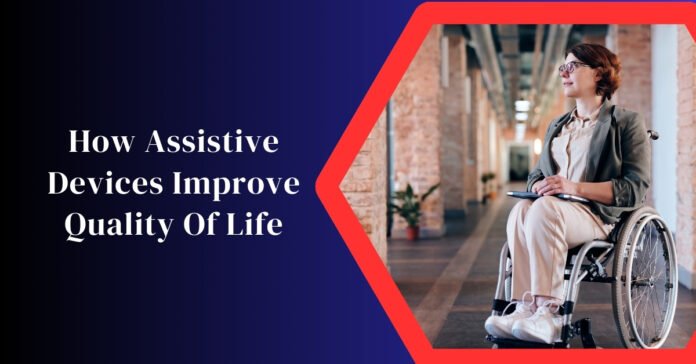Assistive devices play a pivotal role in enhancing the quality of life for individuals with disabilities, injuries, or age-related challenges. These specialized tools not only promote independence but also empower users to engage more fully in their daily activities and social interactions. In this blog, we’ll explore how assistive devices can transform lives and improve overall well-being.
What Are Assistive Devices?
Assistive devices are specialized tools designed to aid individuals in performing tasks they may find challenging due to physical limitations. They encompass a wide range of products, including mobility aids like wheelchairs and walkers, daily living aids such as grab bars and adaptive utensils, and sensory aids like hearing aids and magnifiers. By providing essential support, these devices enable users to navigate their environments with greater ease and confidence.
Key Benefits of Assistive Devices
Enhanced Independence
One of the most significant benefits of assistive devices is the independence they provide. Many individuals who rely on these tools find they can perform daily tasks—such as cooking, cleaning, or personal grooming—on their own. This newfound autonomy fosters self-confidence and a sense of accomplishment, leading to a more fulfilling life.
Increased Participation in Society
Assistive devices facilitate greater engagement in social activities and community events. For instance, mobility aids help individuals with limited mobility attend social gatherings, enjoy outings, or participate in group activities, reducing feelings of isolation and promoting social connections. The ability to move freely and confidently can enrich relationships and enhance overall happiness.
Improved Safety
Safety is a critical concern for individuals with disabilities or age-related challenges. Many assistive devices are designed to prevent accidents and minimize risks. For example, grab bars installed in bathrooms provide support and stability, significantly reducing the risk of falls. Additionally, smart home devices can alert caregivers or family members in case of emergencies, further enhancing safety.
Enhanced Communication and Social Interaction
For those with hearing or speech difficulties, assistive devices can profoundly improve communication. Hearing aids amplify sounds, allowing users to engage in conversations and enjoy social interactions more fully. Similarly, communication devices can help individuals who cannot speak express their thoughts and feelings, fostering better relationships and reducing feelings of frustration.
Customized Solutions for Individual Needs
One of the great advantages of assistive devices is their ability to be tailored to meet individual needs. Occupational therapists often work closely with clients to determine the most suitable devices based on their unique challenges and lifestyle goals. This personalized approach ensures that users receive the maximum benefit from their assistive technology and that the devices effectively address their specific requirements.
Types of Assistive Devices
To understand how these devices improve quality of life, it’s essential to recognize the various types available:
Prosthetic Devices
- Transfemoral Prosthesis: For individuals who have lost a limb above the knee.
- Transtibial Prosthesis: Designed for those who have lost a leg below the knee.
- Transradial Prosthesis: For users who have lost a limb below the elbow.
- Transhumeral Prosthesis: Aids those missing a limb above the elbow.
Specialized prosthetic limbs Manufacturer in Delhi offer a variety of innovative options to enhance mobility and independence.
Orthotic Devices
-
- Knee Braces: Provide stability and support to the knee joint.
- Ankle-Foot Orthoses (AFOs): Help with foot drop and maintain proper foot alignment.
- Back Supports: Aid in posture correction and alleviate back pain.
Mobility Aids
-
-
- Wheelchairs: Manual and powered options for varying levels of independence.
- Walkers: Offer support for individuals with balance or strength issues.
- Canes: Provide stability for those who need assistance with walking.
-
Visual Aids
-
- Glasses and Contact Lenses: Correct refractive errors.
- Magnifying Devices: Assist with reading and seeing details.
Daily Living Aids
- Grab Bars: Installed in bathrooms to prevent slips and falls.
- Reaching Aids: Help individuals retrieve items from high shelves without strain.
Choosing the Right Assistive Device
Selecting the right assistive device can be daunting due to the multitude of options available. Here are some tips to help you make an informed decision:
-
Assess Your Needs: Identify which daily activities are challenging and determine which types of devices will be most beneficial.
-
Consult Professionals: Speak with healthcare providers or assistive technology specialists who can provide insights on the best options tailored to your needs.
-
Try Before You Buy: Many organizations offer trial programs, allowing you to test different devices to find the best fit before making a purchase.
-
Consider Budget and Insurance: Assistive devices can vary significantly in cost, so check with your insurance provider for coverage options or financial assistance programs.
-
Seek User Feedback: Reading reviews and testimonials from other users can provide valuable insights into the effectiveness and usability of specific devices.
The Future of Assistive Devices
The field of assistive technology is constantly evolving, with new innovations emerging that enhance the lives of individuals with disabilities. From artificial intelligence predicting user needs to wearable technology that monitors health conditions, the future is promising for assistive devices. Such advancements will continue to improve accessibility and promote independence.
Embrace Independence: A Brighter Future with Assistive Devices!
Assistive devices play a crucial role in enhancing the quality of life for individuals facing physical limitations. By promoting independence, safety, and social interaction, these tools empower users to lead more fulfilling lives. As technology continues to advance, the possibilities for assistive devices will expand, offering even more opportunities for individuals to thrive.
Whether you’re seeking mobility aids, communication devices, or daily living tools, remember that assistive resources are available to support you in leading a more independent and enriching life. Embrace the potential of assistive devices and discover how they can make a difference today!

